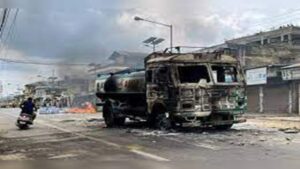Table of Contents
INTRODUCTION
The northeastern state is a beautiful part of India, with its population spread across hills and valleys. It has a rich culture. And it has given the country some of the best sportspersons who have won international laurels.
Ever so often, Manipur is facing large-scale violence in many areas that the state had to deploy its Army overnight and impose shoot-at-sight orders to contain such violence. This clash broke out between the tribals and the majority Meiteis community, displacing over 9,000 people for safety purposes.

What is happening in Manipur?
Manipur has a history of violence and unrest due to various factors such as ethnic tensions, separatist movements, and disputes over land and resources.
One of the major conflicts in Manipur is between the Indian government and various insurgent groups seeking greater autonomy or independence for the state. This conflict has resulted in violence, including bombings, shootings, and kidnappings.
Another significant issue in Manipur is the conflict between different ethnic groups living in the state. The Meitei, Nagas, and Kukis are some of the major ethnic groups in Manipur, and there have been tensions and violence between them over issues such as land ownership and political representation.
In recent years, there have also been reports of violence against women in Manipur, including incidents of rape and murder. Human rights organizations have raised concerns about the lack of accountability for these crimes and the failure of the authorities to address them effectively.
Overall, Manipur continues to face significant challenges related to violence and conflict, and there is a need for sustained efforts to address these issues and promote peace and stability in the state
High Court’s direction to the state government on including Meiteis (Imphal Valley-based) in the Scheduled Tribes category.
- Meiteis are about 53% of the state’s population but occupy about 10% of Manipur’s land area. If Meiteis are included in the ST list, then they can now purchase land in Manipur hills inhabited by tribals.
- Also, the Manipuri language of the Meiteis is included in the Eighth Schedule of the Constitution, and the sections of the Meitei community which is predominantly Hindu — are already classified under Scheduled Castes (SC) or Other Backward Classes (OBC) and have access to the opportunities related to this status.
Internet ban in Manipur
Mobile internet services have been suspended for 5 days in the state amid incidents of fighting between young men and volunteers of different communities.
Demand for Scheduled Tribe status for Meiteis
The Manipur High Court on April 20th, directed the state government to consider the Meitei community’s request to be included in the Scheduled Tribes list within 4 weeks. The HC asked that the recommendation be sent to the Central government for its consideration. This move is what’s being objected to by the Kuki organisations who are protesting against the Meiteis ST status & held a ‘Tribal Solidarity March’. Kukis fear that if Meiteis are given ST status, they will take all their land areas in hill districts.
Meiteis claims that the protest against ST status is fake. The Kukis are mostly worried by the state government’s drive to eradicate illegal immigrants from settlements in reserve forest areas in the hill districts.
“They seized opportunity in the garb of the protest against the ST status, but their main problem is the eviction drive. But the drive is being conducted across Manipur, not just in the Kuki area,” Chand Meetei Pocshangbam, member of All Meitei Council stated.
Police authorized to shoot at protesting MOB.?
As per the laws- No, the police are not authorized to shoot at sight at a protesting mob under the Indian Penal Code (IPC). The use of force by the police is regulated by the law, and it must be necessary and proportionate to the situation.
Section 129 of the Code of Criminal Procedure (CrPC) provides for the dispersal of unlawful assemblies. It states that if an assembly of five or more persons is likely to cause a disturbance of the public peace, the police can issue a proclamation ordering them to disperse. If the assembly does not disperse, the police may use force to disperse them, but the force used should be the minimum necessary to achieve the objective.
However, the police can use lethal force in certain circumstances, such as in self-defense or in the defense of others, or when it is necessary to prevent the commission of a serious offense that threatens human life or property. The use of lethal force must be strictly necessary and proportionate to the threat posed.
- The Code of Criminal Procedure (CrPC) and the Indian Penal Code (IPC) govern the use of force by police officers.
- These laws also make it clear that even in situations where the use of force is authorised, police officers must use the minimum amount of force mandatory to achieve their objective and ensure that their actions are proportionate to the threat faced (Section 99 of IPC).
- Hence, indiscriminate firing on a protesting mob is illegal in India.
- Also, the right to peaceful assembly and protest is a fundamental right guaranteed in the Indian Constitution. The police are obligated to facilitate such protests and ensure the safety and security of the protesters. Still, the protest has to be “peaceful”; if not, then the police can use force but starting with a minimum amount to achieve the goal.
MUST READ
SUICIDE CASE OF ACTRESS JIAH KHAN
HIGHEST-PAID LAWYERS IN INDIA-2023
